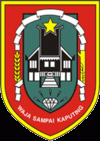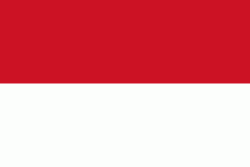South Kalimantan (Kalimantan Selatan) is a province of Indonesia. It is the smallest province in Kalimantan, the Indonesian territory of Borneo. The provincial capital was Banjarmasin until 15 February 2022 when it was legally moved to Banjarbaru. The population of South Kalimantan was recorded at just over 3.625 million people at the 2010 Census, and at 4.07 million at the 2020 Census. The official estimate as at mid 2021 was 4,112,576. One of the five Indonesian provinces in Kalimantan, it is bordered by the Makassar Strait in the east, Central Kalimantan in the west and north, the Java Sea in the south, and East Kalimantan in the north. The province also includes the island of Laut, located off the eastern coast of Kalimantan. The province is divided into 11 regencies and 2 cities. South Kalimantan is the traditional homeland of the Banjar people, although some parts of East Kalimantan and Central Kalimantan are also included in this criteria. Nevertheless, South Kalimantan, especially the former capital city Banjarmasin has always been the cultural capital of Banjarese culture. Many Banjarese have migrated to other parts of Indonesia, as well as neighbouring countries such as Singapore and Malaysia. In addition, other ethnic groups also inhabit the province, such as several groups of the Dayaks, who mostly live in the interior part of the province, as well as the Javanese, who mostly migrated from Java due to the Transmigration program which dated from the Dutch colonial era.
The history of South Kalimantan was synonymous with the establishment of the Kingdom of Tanjung Puri around the 5th to 6th century AD. This kingdom is strategically located at the foot of the Meratus Mountains and on the banks of a large river so that later it becomes a fairly well-developed city. Soon after, the Kingdom of Negara Dipa was established by immigrants from Java. In the 15th century, an attack from Java nearly destroyed this Kingdom of Dipa. To save the kingdom, the new dynasty led by Maharaja Sari Kaburangi immediately ascended the throne and moved the center of government towards the downstream, namely towards the sea at Muhara Rampiau. The Kingdom of Dipa avoided total destruction, it renamed itself as the Kingdom of Negara Daha. The Negara Daha eventually suffered a setback with the emergence of a power struggle that took place since Raden Samudra took up arms from the direction of the estuary, in addition to also establishing settlement for the patih who were in the estuary. This settlement would form the predecessor of the modern-city of Banjarmasin. With help from Mangkubumi Aria Taranggana, Raden Samudra converted to Islam on September 24, 1526, changing his name to Sultan Suriansyah, and changed the name of Negara Daha to the Sultanate of Banjar. Banjar at first paid tribute to the Sultanate of Demak. That state met its demise in the mid-16th century, however, and Banjar was not required to send tribute to new power in Java, the Sultanate of Pajang. Banjar rose in the first decades of the 17th century as a producer and trader of pepper. Soon, virtually all of the southwest, southeast, and eastern areas of Kalimantan island were paying tribute to the sultanate. Sultan Agung of Mataram (1613–1646), who ruled north Java coastal ports such as Jepara, Gresik, Tuban, Madura and Surabaya, planned to colonise the Banjar-dominated areas of Kalimantan in 1622, but the plan was cancelled due to inadequate resources. Europeans began arriving in the region in the 16th century. The Dutch initially built a trade post in the region, but was expelled by the British during the Napoleonic Wars. After the war ended, the British returned the region to the Dutch. A new round of history in South Kalimantan began with the rise of the people against the Dutch. Prince Antasari led the resistance against the Dutch, whom eventually abolished the sultanate, while Sultan Muhammad Seman, who became its leader, died in battle. Afterwards South Kalimantan was fully controlled by the Dutch. Japanese forces took control of the region in 1942, resulting in the three years of brutal occupation before surrendering in 1945. The Dutch briefly returned to assume control, but this resulted in a nationwide resistance. In 1949, the Dutch left and control of the region was handed to the new Indonesian Government.























